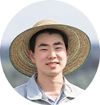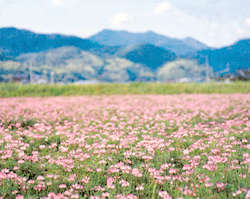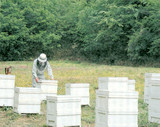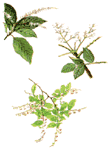 |
| Bee Square HOME | The Miraculous Life of Bees | A Surprising Story about Bees | Look into a honeycomb! | An Introduction to Beekeeping |
| Honeybee Restaurant | Beekeeping Reports from Around the World | Fairy Tales and Picture Books about Bees Story Collection | News From the Bee Farm | Links |
|
|
|
 Takayuki Ono Yamada Bee Farm, Beekeeping Division |
|
This year was warm from the beginning of the year, and just when we thought the mild winter was over it turned very cold for a stretch in February. Most days from March to April remained colder than average, and we had snow flurries instead of swelling buds on the cherry trees as in a normal year. This cold weather delayed the budding and blooming of field flowers, which likewise delayed the propagation of worker bees. Clover flowers, which are the spring's biggest source of honey, were late and only reached full bloom toward the end of April. Overall, everything happened 10 days later this year than last year.
As the number of worker bees in the hive increases there becomes less and less space for storing honey and for laying eggs. When this happens, the honeybees leave the hive to propagate. A young queen bee is reared, and before it hatches the old queen bee leaves the hive up to half of the honeybees. This is known as "absconding," or "swarming." The swarm may cluster on trees lining a street or garden trees and often cause people trouble, even sometimes making news. Many people at one time or another have seen such a swarm of bees. After gathering temporarily on a tree branch or other location, they fly off in search of a new home. The professional beekeeper must take effective measures to prevent swarming.
A great variety of flowers bloom in the mountains of Kagamino at this time, providing sources of honey. These include: persimmon, chestnut, horse chestnut, wax-tree, eggplant, sunflower, wild mustard, pepper tree, and buckwheat. The honey from these trees falls into the category of "Deep-Mountain 100-Flower Honey." With these flowers, however, there may be little nectar in some years and a lot in others. (Beekeepers call this time when there is abundant nectar available a "honey flow.") With tree flowers, unlike field flowers such as clover and rapeseed, the amount of honey that can be obtained can vary widely from year to year.
It is therefore not easy to answer this question that we often get: "What flowers does Deep-Mountain 100-Flower Honey come from?" Why is there honey flow some years and not others in the same place where the same flowers bloom every year? We don't know why. It is how nature works, but I'm sure there is a reason to be found in there somewhere. |
|||||
Yamada Bee Farm (Kagaminocho Pref. Okayama)
Copyright(C)2005 Yamada Bee Farm All Rights Reserved.
|



